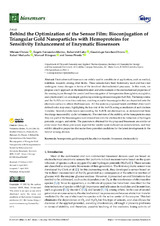Mostrar el registro sencillo del ítem
Behind the Optimization of the Sensor Film: Bioconjugation of Triangular Gold Nanoparticles with Hemoproteins for Sensitivity Enhancement of Enzymatic Biosensors
| dc.contributor.author | Chávez, Miriam | |
| dc.contributor.author | Fernández-Merino, Ángela | |
| dc.contributor.author | Del Caño-Ochoa, Rafael | |
| dc.contributor.author | Sánchez-Obrero, Guadalupe | |
| dc.contributor.author | Madueño, Rafael | |
| dc.contributor.author | Blázquez, Manuel | |
| dc.contributor.author | Pineda, Teresa | |
| dc.contributor.author | Chávez, Miriam | |
| dc.contributor.author | Fernández-Merino, Ángela | |
| dc.date.accessioned | 2023-04-10T11:48:30Z | |
| dc.date.available | 2023-04-10T11:48:30Z | |
| dc.date.issued | 2023 | |
| dc.identifier.uri | http://hdl.handle.net/10396/25085 | |
| dc.description.abstract | Electrochemical biosensors are widely used in a multitude of applications, such as medical, nutrition, research, among other fields. These sensors have been historically used and have not undergone many changes in terms of the involved electrochemical processes. In this work, we propose a new approach on the immobilization and enhancement of the electrochemical properties of the sensing layers through the control and bioconjugation of hemoproteins (hemoglobin, myoglobin, and cytochrome C) on anisotropic gold nanoparticles (gold nanotriangles (AuNTs)). The hemeproteins and the AuNTs are mixed in a solution, resulting in stable bioconjugates that are deposited onto the electrode surface to obtain the biosensors. All the systems proposed herein exhibited direct well-defined redox responses, highlighting the key role of the AuNTs acting as mediators of such electron transfers. Several protein layers surrounding the AuNTs are electroactive, as demonstrated from the charge measured by cyclic voltammetry. The retention of the stability of the hemeproteins once they are part of the bioconjugates is evidenced towards the electrocatalytic reduction of hydrogen peroxide, oxygen, and nitrite. The parameters obtained for the proposed biosensors are similar or even lower than those previously reported for similar systems based on nanomaterials, and they exhibit attractive properties that make them potential candidates for the latest developments in the field of sensing devices. | es_ES |
| dc.format.mimetype | application/pdf | es_ES |
| dc.language.iso | eng | es_ES |
| dc.publisher | MDPI | es_ES |
| dc.rights | https://creativecommons.org/licenses/by/4.0/ | es_ES |
| dc.source | Biosensors, 13(4), 467 (2023) | es_ES |
| dc.subject | Hemeprotein | es_ES |
| dc.subject | Gold nanoparticles | es_ES |
| dc.subject | Electron transfer | es_ES |
| dc.subject | Biosensor | es_ES |
| dc.subject | Electroactivit | es_ES |
| dc.title | Behind the Optimization of the Sensor Film: Bioconjugation of Triangular Gold Nanoparticles with Hemoproteins for Sensitivity Enhancement of Enzymatic Biosensors | es_ES |
| dc.type | info:eu-repo/semantics/article | es_ES |
| dc.relation.publisherversion | https://doi.org/10.3390/bios13040467 | es_ES |
| dc.relation.projectID | Gobierno de España. RED2018- 102412-T | es_ES |
| dc.relation.projectID | Junta de Andalucía. 1265074-2B (FEDER) | es_ES |
| dc.rights.accessRights | info:eu-repo/semantics/openAccess | es_ES |

